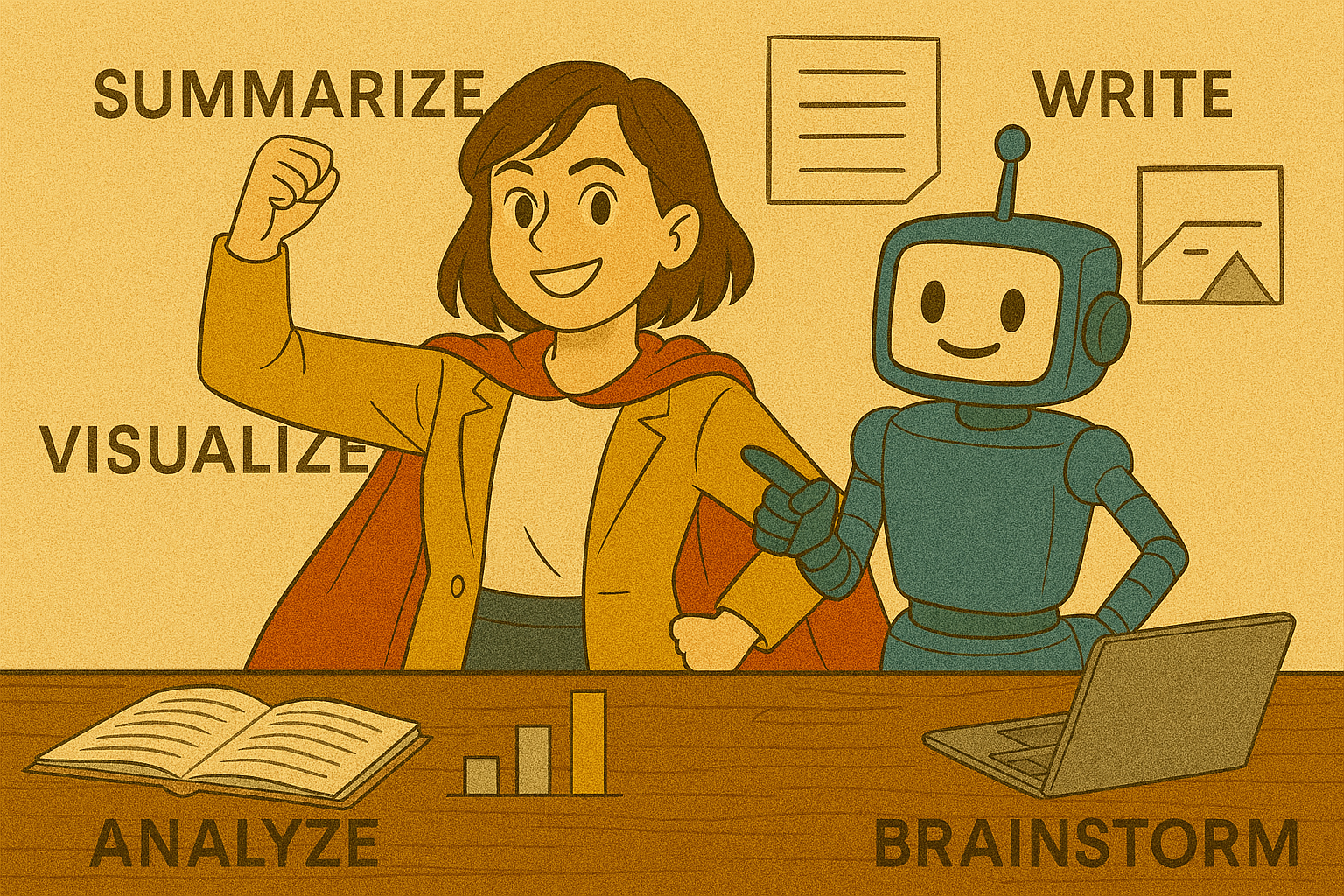While debates about AI adoption continue, forward-thinking professionals have already gained a significant head start. If your work involves writing, analysis, design, or decision-making – AI is already reshaping how it’s done. My recent talk “AI Unlocked” to an audience of technical and business professionals, demonstrated six practical applications with actionable prompting strategies that deliver immediate value.
Meet Your AI Co-Worker
Imagine starting your day at work to find your AI co-worker has already:
- Extracted insights from a dense research paper
- Drafted emails matching your communication style
- Outlined key points for your upcoming meeting
- Cleaned your dataset and generated visualizations
- Created concept images for your proposal
This isn’t hypothetical – it’s happening now. Professionals across functions are using AI to think faster, create better, and make smarter decisions.
I demonstrated Microsoft Copilot, Anthropic Claude, OpenAI ChatGPT, Google Gemini, and Google NotebookLM – each with its unique strengths. But here’s a crucial insight: you don’t need all of them. Choose one tool, learn it deeply, and build your capabilities from there.
The Secret Sauce: Better Prompting
AI can’t read minds. Clear context creates better results.
Instead of:
Summarize this report.
Try:
You are a product strategist at a renewable energy company. Summarize this article on battery storage innovation for your executive leadership team. Focus on strategic implications, potential partnerships, and next-step recommendations. Write in a clear, executive-ready tone.
The difference is remarkable. Want to improve? Ask the AI itself:
How can I improve this prompt? Rewrite it to be clearer and more targeted.
Six Ways AI Is Already Earning Its Keep
Building on the Jobs-To-Be-Done framework that identifies specific goals or “jobs” that customers aim to accomplish when they purchase a product, I identified jobs where I could “hire” AI to assist me as a business and technology professional.
1. Summarize with the Knowledge Translator
Using Copilot, I transformed a 56-page academic paper on “The Cybernetic Teammate” into three distinct formats: an academic case study, a graduate literature review, and a concise executive briefing—all in minutes.
2. Analyze with the Data Analyst
With ChatGPT, I sourced energy generation data, visualized historical trends, and projected future patterns with Python – collapsing hours of multi-tool work into a single conversation.
3. Write with the Communications Expert
Claude helped craft a technical brief on AI’s impact on critical thinking, then transformed it into executive-friendly language with one follow-up prompt -maintaining accuracy while enhancing clarity – and Claude helped me build out the prompt.
4. Brainstorm with the Strategic Thought Partner
GPT-4.5 helped explore an AI consulting business concept, suggesting business models, revenue approaches, and target customers – not replacing my thinking but accelerating it and revealing new possibilities.
5. Learn with the Research Assistant
NotebookLM digested multiple papers on GenAI in manufacturing, compared methodologies, and even created a podcast summary for on-the-go learning – making research portable and accessible.
6. Visualize with the Image Generator
Gemini helped visualize a diverse team of women engineers in a futuristic lab setting, iteratively refining the image through simple prompts—creating a path from concept to visual representation without design tools.
Practice Safe Prompting
With great power comes great responsibility. To use AI effectively and ethically:
- Protect sensitive information — Don’t share anything confidential
- Validate outputs — Always fact-check AI-generated content
- Watch for bias — Review tone and underlying assumptions
- Own the outcome — AI drafts, you decide and take responsibility
- Understand attribution — Know what you’re generating and why
For a deeper dive into how you can incorporate prompts that will protect you from hallucinations, plagiarism and more, read my post on Practice Safe AI with Responsible Prompting.
Your Step-by-Step AI Transformation Plan
You don’t need a full workflow overhaul to benefit from AI. Try this focused approach:
Step 1: Information Synthesis – Summarize a dense article into insights for your specific role
Step 2: Content Architecture – Generate outlines for your next proposal or presentation
Step 3: Communication Refinement – Translate technical content for different audiences
Step 4: Knowledge Organization – Transform messy notes into a structured document
Track what works. Save effective prompts. Share your discoveries.
The Edge That Matters
The distinction isn’t between professionals who use AI and those who don’t – it’s between those who use it strategically and those who merely dabble.
Develop AI fluency now. Try one new tool this week. Lead the transformation in your organization to combine human judgment with AI capabilities.
The future of work isn’t just coming – it’s already here. Let’s shape it together, responsibly.
Visit deeplyproduct.com for curated content on courses, books, podcasts and responsible prompting frameworks.






